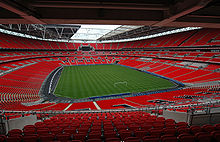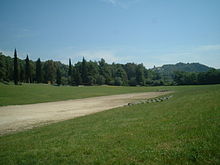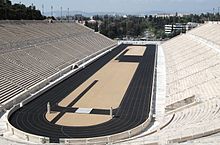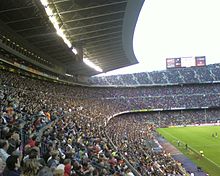- Stadium
-
This article is about the building type. For other uses, see Stadium (disambiguation).
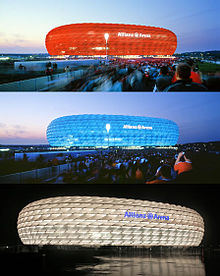 The Allianz Arena in Munich, Germany is the first stadium that can change the color of its exterior.
The Allianz Arena in Munich, Germany is the first stadium that can change the color of its exterior.
 The Veltins-Arena in Gelsenkirchen, Germany is an example of a stadium with a retractable roof and a retractable pitch
The Veltins-Arena in Gelsenkirchen, Germany is an example of a stadium with a retractable roof and a retractable pitch
A modern stadium (plural stadiums/stadia[2]) is a place or venue for (mostly) outdoor sports, concerts, or other events and consists of a field or stage either partly or completely surrounded by a structure designed to allow spectators to stand or sit and view the event.[3])
Pausanias noted that for about half a century the only event at the ancient Greek Olympic festival was the race that comprised one length of the stade at Olympia, where the word "stadium" originated.[4]
Contents
History and etymology
The Stadium in Olympia
"Stadium" comes from the Greek word "stadion" (στάδιον), a measure of length equalling approximately 200 metres.[4] The oldest known stadium is the one in Olympia, in the western Peloponnese, Greece, where the Olympic Games of antiquity were held since 776 BC. Initially 'the Games' consisted of a single event, a sprint along the length of the stadium. Therefore the length of Olympia's stadium became somewhat of a standard measure of distance.
A Roman stadium was slightly smaller, a distance of 125 passus (double-paces), equal to about 185 meters or 607 feet. The English use of stadium comes from the tiered infrastructure surrounding a Roman track of such length. Although most dictionaries provide for both "stadiums" and "stadia" as valid plurals, etymological sticklers sometimes apply "stadia" only to measures of length in excess of 1 stadium. (That the "stadium" measurement is used only in historical contexts perhaps explains the sustained use of the archaic plural.) Greek and Roman stadiums have been found in numerous ancient cities, perhaps the most famous being the Stadium of Domitian, in Rome.
The first stadium to be used in modern times, and the only one to be used during the 19th century, was the excavated and refurbished ancient Panathenaic stadium which has hosted Olympic Games in 1870,[5] 1875, 1896, 1906, and 2004. The excavation and refurbishment of the stadium was part of the legacy of the Greek national benefactor Evangelos Zappas.
The modern stadium
Types
Dome stadiums are distinguished from conventional stadiums by their enclosing roofs. Many of these are not actually domes in the pure architectural sense, some being better described as vaults, some having truss-supported roofs, and others having more exotic designs such as a tensegrity structure. But, in the context of sports stadiums, the term "dome" is standard for all covered stadiums.[6] Some stadiums have partial roofs, and a few have even been designed to have moveable fields as part of the infrastructure.
Even though enclosed, dome stadiums are called stadiums because they are large enough for, and designed for, what are generally considered to be outdoor sports. Those designed for what are usually indoor sports are generally called arenas. Exceptions include the basketball arena at Duke University, which is called Cameron Indoor Stadium, Red Bull Arena, which is home of the New York Red Bulls of the MLS, and the now-demolished Chicago Stadium, former home of the Chicago Blackhawks of the NHL and Chicago Bulls of the NBA.
Design issues
 Popular industrial Stadium in Bayda, Libya.
Popular industrial Stadium in Bayda, Libya.
Different sports require fields of different size and shape. Some stadiums are designed primarily for a single sport while others can accommodate different events, particularly ones with retractable seating. Stadiums built specifically for Association Football are quite common in Europe; however, Gaelic games stadiums (such as Croke Park) would be most common in Ireland, while ones built specifically for baseball or American Football are common in the United States. The most common multiple use design combines a football pitch with a running track, a combination which generally works fairly well, although certain compromises must be made. The major drawback is that the stands are necessarily set back a good distance from the pitch, especially at the ends of the pitch. In the case of some smaller stadiums, there are not stands at the ends. When there are stands all the way around, the stadium takes on an oval shape. When one end is open, the stadium has a horseshoe shape. All three configurations (open, oval and horseshoe) are common, especially in the case of American college football stadiums. Rectangular stadiums are more common in Europe, especially for football where many stadiums have four often distinct and very different stands on the four sides of the stadium. These are often all of different sizes and designs and have been erected at different periods in the stadium's history. The vastly differing character of European football stadiums has led to the growing hobby of ground hopping where spectators make a journey to visit the stadium for itself rather than for the event held there. In recent years the trend of building completely new oval stadiums in Europe has led to traditionalists criticising the designs as bland and lacking in the character of the old stadiums they replace.
In North America, where baseball and American football are the two most popular outdoor spectator sports, a number of football/baseball multi-use stadiums were built, especially during the 1960s, and some of them were successful.
However, since the requirements for baseball and football are significantly different, the trend, beginning with Kansas City in 1972–1973 and accelerating in the 1990s, has been toward the construction of single-purpose stadiums. In several cases, an American football stadium has been constructed adjacent to a baseball park. In many cases, earlier baseball stadiums were constructed to fit into a particular land area or city block. This resulted in asymmetrical dimensions for many baseball fields. Yankee Stadium, for example, was built on a triangular city block in The Bronx, New York City. This resulted in a large left field dimension but a small right field dimension.
Before more modern football stadiums were built in the United States, many baseball parks, including Fenway Park, the Polo Grounds, Wrigley Field, Comiskey Park, Tiger Stadium, Griffith Stadium, Milwaukee County Stadium, Shibe Park, Forbes Field, Yankee Stadium, and Sportsman's Park were used by the National Football League or the American Football League. Along with today's single use stadiums is the trend for retro style ballparks closer to downtown areas. Oriole Park at Camden Yards was the first such ballpark for Major League Baseball to be built, using early 20th century styling with 21st century amenities.
Spectator areas and seating
An "all-seater" stadium has seats for all spectators. Other stadiums are designed so that all or some spectators stand to view the event. The term "all-seater" is not common in the U.S., perhaps because very few American stadiums have sizeable standing-only sections. Poor stadium design has contributed to disasters, such as the Hillsborough disaster and the Heysel Stadium disaster. Since these, both the FA Premier League and FIFA World Cup qualifying matches require all spectators to be seated (though not necessarily in an all-seater stadium, if terraces are left empty).
The spectator areas of a stadium may be referred to as bleachers, especially in the U.S., or as terraces, especially in the United Kingdom, but also in some American baseball parks, as an alternative to the term tier. Originally set out for standing room only, they are now usually equipped with seating. Either way, the term originates from the step-like rows which resemble agricultural terraces. Related, but not precisely the same, is the use of the word terrace to describe a sloping portion of the outfield in a baseball park, possibly, but not necessarily for seating, but for practical or decorative purposes. The most famous of these was at Crosley Field in Cincinnati, Ohio.
Many stadiums make luxury suites or boxes available to patrons at high prices. These suites can accommodate fewer than 10 spectators or upwards of 30 depending on the venue. Luxury suites at events such as the Super Bowl can cost hundreds of thousands of dollars.
Corporate naming
See also: Naming rights and List of sports venues with sole naming rightsIn recent decades, to help take the burden of the massive expense of building and maintaining a stadium, many American and European sports teams have sold the rights to the name of the facility. This trend, which began in the 1970s, but accelerated greatly in the 1990s, has led to sponsors' names being affixed to both established stadiums and new ones. In some cases, the corporate name replaces (with varying degrees of success) the name by which the venue has been known for many years. But many of the more recently built stadiums, like the Volkswagen Arena in Wolfsburg, Germany, have never been known by a non-corporate name. The sponsorship phenomenon has since spread worldwide. There remain a few municipally-owned stadiums, which are often known by a name that is significant to their area (for example, Minneapolis' Hubert H. Humphrey Metrodome). In recent years, some government-owned stadiums have also been subject to naming-rights agreements, with some or all of the revenue often going to the team(s) that play there.
One consequence of corporate naming has been an increase in stadium name changes, when the namesake corporation changes its name, or if the naming agreement simply expires. Phoenix's Chase Field, for example, was previously known as Bank One Ballpark, but was re-named to reflect the takeover of the latter corporation. San Francisco's historic Candlestick Park was renamed as 3Com Park for several years, but the name was dropped when the sponsorship agreement expired, and it was another two years before the new name of Monster Cable Products' Monster Park was applied. Local opposition to the corporate naming of that particular stadium led San Francisco's city council to permanently restore the Candlestick Park name once the Monster contract expired. More recently, in Ireland, there has been huge opposition to the renaming of Dublin's historic Lansdowne Road as the Aviva Stadium. Lansdowne was redeveloped as the Aviva, opening in May 2010.
On the other hand, Los Angeles' Great Western Forum, one of the earliest examples of corporate re-naming, retained its name for many years, even after the namesake bank no longer existed, the corporate name being dropped only after the building later changed ownership. This practice has typically been less common in countries outside the United States. A notable exception is the Nippon Professional Baseball league of Japan, in which many of the teams are themselves named after their parent corporations. Also, many new European football stadiums, such as the Reebok and Emirates Stadiums in England and Signal Iduna Park and Allianz Arena in Germany have been corporately named.
This new trend in corporate naming (or re-naming) is distinguishable from names of some older venues, such as Crosley Field, Wrigley Field, and the first and second Busch Stadiums, in that the parks were named by and for the club's owner, which also happened to be the name of the company owned by those clubowners. (The current Busch Stadium received its name via a modern naming rights agreement.) The SkyDome in Toronto, Canada was renamed Rogers Centre in 2005, removing any reference that it is a domed stadium.
During the 2006 FIFA World Cup in Germany, some stadiums were temporarily renamed because FIFA prohibits sponsorship of stadiums, unless the stadium sponsors are also official FIFA sponsors. For example, the Allianz Arena in Munich was called the FIFA World Cup Stadium, Munich during the tournament. Likewise, the same stadium will be known as the "München Arena" during the European Competitions. Similar rules affect the Imtech Arena and Veltins-Arena. Corporate names are also temporarily replaced during the Olympics. During the 2010 Winter Olympics in Vancouver for example, General Motors Place was called Canada Hockey Place.
Music venues
Main article: Stadium rock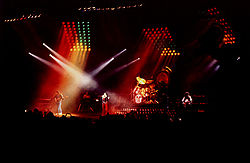 A Queen concert in Drammen, Norway in 1982, showing the scale and lighting of an arena rock concert
A Queen concert in Drammen, Norway in 1982, showing the scale and lighting of an arena rock concert
From the 1960s stadiums began to be used as live music venues, giving rise to the term "stadium rock", particularly for forms of hard rock and progressive rock. The origins of stadium rock are sometimes dated to when The Beatles played Shea stadium in New York in 1965. Also important was the use of large stadiums for American tours by bands in the later 1960s, such as The Rolling Stones, Grand Funk Railroad and Led Zeppelin. The tendency developed in the mid-1970s as the increased power of amplification and sound systems allowed the use of larger and larger venues.[7] Smoke, fireworks and sophisticated lighting shows became staples of arena rock performances.[8] Key acts from this era included Journey, REO Speedwagon, Boston, Foreigner, Styx,[9] Kiss, Peter Frampton[10] and Queen.[11][12] In the 1980s arena rock became dominated by glam metal bands, following the lead of Aerosmith[13] and including Mötley Crüe, Quiet Riot, W.A.S.P. and Ratt.[14] Since the 1980s pop stars including Madonna, Britney Spears and Taylor Swift have undertaken large scale stadium based tours.[citation needed]
See also
- List of indoor arenas
- List of sports attendance figures
- List of stadiums
- List of stadia by capacity
- Olympic Stadium
- Stad, Stead (as in Homestead), Stadt
- Sport venue
- Sports complex
- Multi-purpose stadium
- Modular stadium
Notes
- ^ "Wembley kick-off: Stadium is ready and England play first game in fortnight". Daily Mail. 2007-03-09. http://www.dailymail.co.uk/pages/live/articles/news/news.html?in_article_id=441182. Retrieved 2007-03-19.
- ^ Stadia is the Latin plural form, but both are used in English. Dictionary.com
- ^ Nussli Group "Stadium Construction Projects"
- ^ a b A Brief History of the Olympic Games by David C. Young, p. 20
- ^ The Modern Olympic Games, A Struggle for Revival by David C. Young, Chapters 4 & 13
- ^ Merriam-Webster, http://www.merriam-webster.com/dictionary/dome
- ^ S. Waksman, This Ain't the Summer of Love: Conflict and Crossover in Heavy Metal and Punk (University of California Press, 2009), ISBN 0520253108, pp. 21-31.
- ^ R. Shuker, Popular Music: the Key Concepts (London: Routledge, 2nd., edn., 2002), 0415284252, p. 158.
- ^ “Arena rock”, Allmusic, retrieved 20 January 2011.
- ^ J. Shepherd, ed., Continuum Encyclopedia of Popular Music of the World, Volume 1 (Continuum, 2003), ISBN 0826463215, p. 423.
- ^ P. Buckley, The Rough Guide to Rock (London: Rough Guides, 3rd edn., 2003), ISBN 1843531054, p. 835.
- ^ Thrills, Adrian (11th March 2011) We STILL rock you: Re-releases chart Queen's rise to power Daily Mail. Retrieved June 16, 2011.
- ^ D. L. Joyner, American Popular Music (McGraw-Hill, 3rd edn., 2008), ISBN 0073526576, p. 261.
- ^ "Hair metal", Allmusic. Retrieved 6 July 2010.
References
- John, Geraint; Rod Sheard; Ben Vickery (2007). Stadia: A Design and Development Guide (4th ed. ed.). Amsterdam: Elsevier/Architectural Press. ISBN 9780750668446.
- Serby, Myron W. (1930). The Stadium; A Treatise on the Design of Stadiums and Their Equipment. New York, Cleveland: American Institute of Steel, inc. (worldcat) (search)
External links
- World Stadiums
- Stadium Archive
- Footballmatch-Stadiumguide
- VisitingFan.com-Reviews of stadiums and arenas
- Stadiumsworld
- Stadiums for Euro2012
- Atlas of worldwide soccer stadiums for GoogleEarth ***NEW***
Infrastructure Bridge · Canal · Dam · Drainage · Footbridge · Interchange · Levee · Overpass · Road · Skyway · Storm drain · Tunnel
See also: Architecture · Amphitheatre · Civil engineering · Construction · Playground · Urban park
Categories:- Sports venues
- Stadiums
- Greek loanwords
Wikimedia Foundation. 2010.

